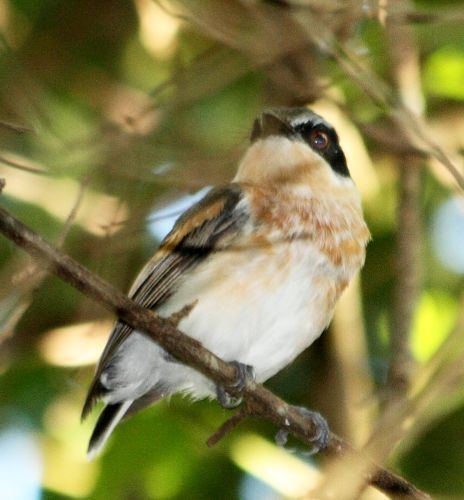Kingdom Animalia Class Aves Family Platysteiridae Scientific name Batis fratrum | Phylum Chordata Order Passeriformes Genus Batis Rank Species | |
 | ||
Similar Pale batis, Batis, Rudd's apalis, Margaret's batis, Ruwenzori batis | ||
Woodward's batis or Zululand batis (Batis fratrum) is a species of small bird in the wattle-eyes family, Platysteiridae. It occurs in south-eastern Africa where it is found in woodlands and forests.
Contents
Description
Woodward's batis is a small active bird which is similar to a flycatcher and shows the typical patterns and plumage colours of the genus Batis. It is blue-grey above with a short white supercilium, black mask on the face, an orange-red eyes and the tail is black with the outer tail fathers edged white and all of the tail feathers except the middle two are tipped with white. It is sexually dimorphic and the male shows white on the wing strip, chin and throat while his breast and upper belly are pale rufous. The female has a browner more olive grey upperparts, pale reddish brown wing stripe and underparts while juveniles are similar but with an indistinct face mask. The bill and the legs are black. The pale batis measures 10.5 cm in length and weighs 10.3–13.8g.
Distribution and habitat
Woodward's batis is indemic to south-eastern Africa from the extreme north east of KwaZulu Natal in South Africa, north to along the coastal northern Mozambique and southern Malawi and inland to the remnant forests of south eastern Zimbabwe.
Woodward's batis prefers lowland and evergreen forest as well as dense acacia woodland, sand forest, riparian forest and miombo woodland. In Malawi it extends up to 600m.
Habits
Woodward's batis actively and continuously forages throughout the day, capturing insect prey by gleaning it from twigs, leaves and branches, typically while hovering in mid-air.
The nest is the typical batis loosely-constructed shallow cup, made out of rootlets, tendrils, fragments of dead leaves and sometimes lichen, bound together with strands of spider web. Unusually for this genus it is usually placed amongst creepers or leaves and rarely in a tree fork. The 1-3 eggs are laid from October-November and these are probably incubated solely by the female, as in most other batises..
Naming
The English and Latin names commemorate its discovery by the Anglican missionaries the Woodward brothers, Robert and John.
